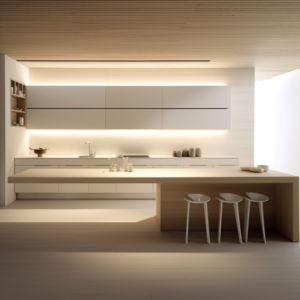In a world filled with constant noise and clutter, many are turning to the minimalist lifestyle to find serenity and balance. Minimalism isn’t just about having less; it’s about embracing the essence of what truly matters in your living spaces.
Minimalist interior design is a practice of simplification, decluttering, and focusing on the fundamental elements that create a harmonious living environment. In this guide, we will explore the art of less and how to embrace minimalism in your home decor.
Defining Minimalism
Minimalism is often misconstrued as stark, cold, or devoid of personality, but this couldn’t be further from the truth. At its core, minimalism seeks to strip away excess, leaving only what is essential. It’s about creating spaces that feel open, serene, and purposeful.
The Minimalist Aesthetic
Minimalist design typically adheres to a few key principles:
- Simplicity: Minimalist spaces are uncluttered, with a focus on clean lines and simple forms. There’s an absence of unnecessary decoration or ornamentation.
- Neutral Colors: A minimalist color palette often revolves around whites, grays, and other neutrals. These colors create a sense of tranquility and allow the eye to rest.
- Functional Furniture: Furniture is chosen for its practicality and function. Pieces are often multi-purpose to maximize utility while minimizing clutter.
- Quality over Quantity: Minimalist decor values quality items over a multitude of possessions. Each piece should be carefully chosen for its beauty and utility.
- Empty Space: Negative space or empty areas are a vital component of minimalist design. These spaces allow for visual rest and give importance to the objects that remain.
Applying Minimalism to Your Home
Now that you have a basic understanding of minimalist design, let’s discuss how to bring it into your home:
- Declutter: Start by ruthlessly decluttering your space. Donate or discard items you no longer need or cherish. Less is more.
- Choose Quality: When adding new furniture or decor, prioritize quality over quantity. Invest in pieces that will stand the test of time.
- Organize Thoughtfully: Implement efficient storage solutions to keep your space tidy and organized.
- Curate Your Decor: Be intentional about the decor items you choose. Each piece should have a purpose and add to the overall aesthetic.
- Create Balance: Maintain a sense of balance and symmetry in your design, even in asymmetrical spaces.
- Introduce Natural Elements: Minimalist design often incorporates natural materials like wood and stone to add warmth and texture.
In the articles to come, we’ll dive deeper into various aspects of minimalist interior design, from creating serene bedrooms to functional and stylish minimalist kitchens. We’ll explore how minimalism can enhance your daily life, promote relaxation, and foster a sense of well-being.
Stay tuned as we embark on this journey to discover “The Art of Less” in the world of interior design.


